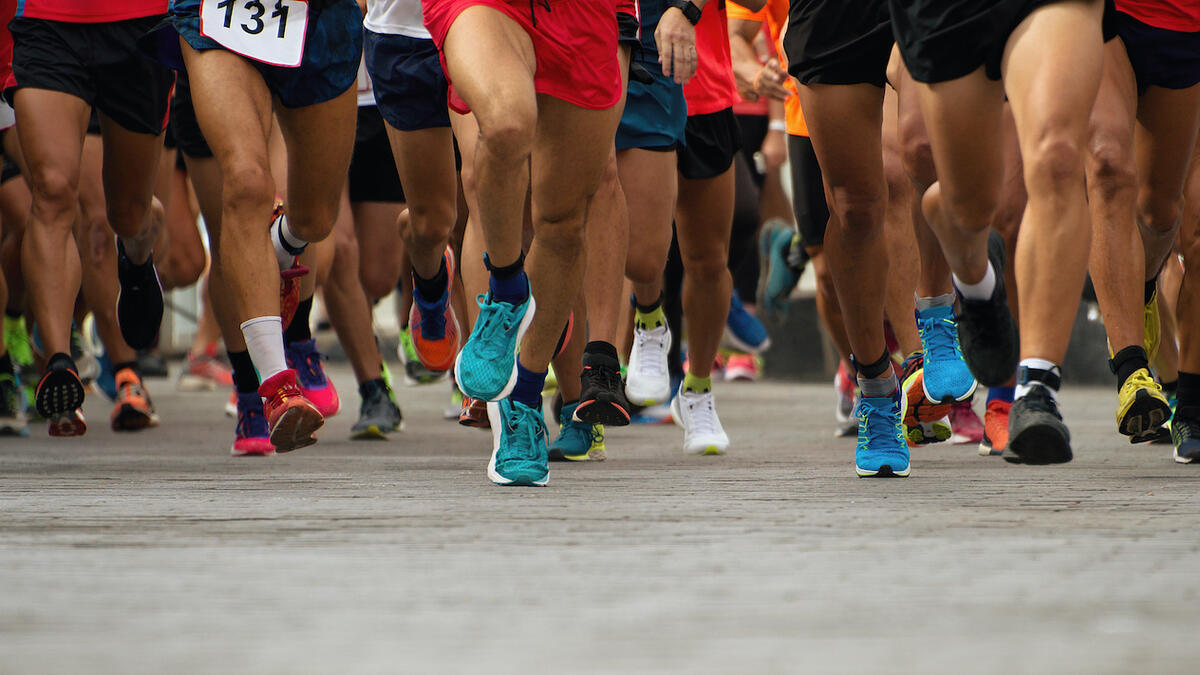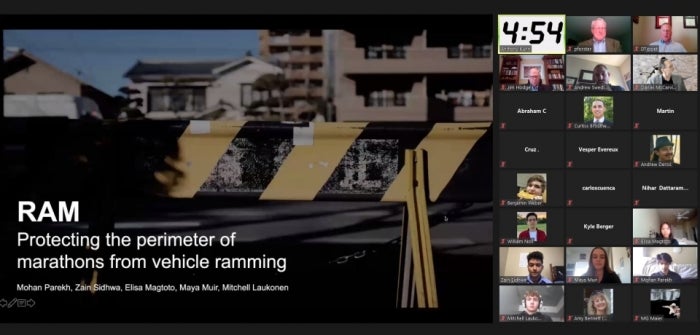ASU, UNLV students collaborate to solve homeland security challenges

Students were asked to design innovative solutions for soft target events like marathons.
In the parlance of homeland security, soft targets are places that are easily accessible to the general public and relatively unprotected. Marathons, large gatherings, sporting events and shopping malls are considered soft targets. Soft targets are challenging to secure. The Department of Homeland Security is working directly with students through programs like Department of Homeland Security Centers of Excellence to discover new and innovative ideas to solve challenging problems like soft targets.
During the weekend of March 26–28, innovative students from both Arizona State University and the University of Nevada, Las Vegas competed in "Hardening Soft Targets" — a design challenge hosted by the Center for Accelerating Operational Efficiency, a DHS Center for Excellence led by ASU.
Hardening Soft Targets was organized as part of Devils Invent, a series of engineering and design challenges from ASU’s Ira A. Fulton Schools of Engineering. During this three-day event, students worked directly with experts from the Department of Homeland Security and the Phoenix Police Department, as well as industry leaders and members of academia who participated as mentors and judges.
The students were given the choice of three timely soft target challenges to work on solving: 1) protecting the perimeter of a marathon from vehicle ramming; 2) designing city infrastructure to prevent vehicle ramming attacks; and 3) ensuring that municipalities’ water systems are protected from cyberattacks.
Bill Bryan, undersecretary (acting) for DHS Science and Technology Directorate, provided opening remarks.
“Those places we call soft targets are usually accessible to a very large number of people, which makes it a real challenge to harden or protect these open and crowded locations such as transportation systems or neighborhood parks,” he said.
He also stated that “bad actors select soft targets because of the number of people in one location and the perceived value of the target.”
Bryan discussed the need for data analytics and database management professionals to help counter the risks of soft targets.
“There’s a growing need: the ability to collect, manage and share real-time information for the security of our citizens while protecting their privacy and civil liberties,” Bryan said.
He closed his remarks by emphasizing how much need there is for today’s students to “reshape the homeland security workforce of the future.”
Former DHS presidential appointee and current adjunct professor at Seton Hall University Mohamad Mirghahari also kicked off the event. Mirghahari gave the students a real-world overview of possible attack scenarios, adversarial actors, security gaps and countermeasure strategies currently being deployed.
“Soft targets can be executed with little or no planning or expertise, and they're often able to remain undetected until operational," Mirghahari said. "Together with the massive amount of soft target locations it presents a significant security challenge.”
He used the example of the Super Bowl to illustrate the substantial number of possible soft targets.
“Instead of potentially targeting the actual Super Bowl there are pregame and lead-up events around the city and near the site, which do not have the (same) security posture as the main event,” he said.
Mirghahari then discussed the importance of design challenges such as this one to give students the opportunities to “engineer the next solutions and ideas.”
The city of Phoenix Police Department and personnel from their Homeland Defense Bureau and Arizona Fusion Center provided technical expertise and resources for planning the event. Sgt. Chris Scranton from Phoenix PD’s Homeland Defense Bureau led the planning efforts and acted as a mentor, providing a local law enforcement perspective to the challenge of soft targets.
At the beginning of the event, students organized themselves into hybrid teams of expertise across major academic disciplines and universities. They then named their teams, selected their scenario of choice and developed strategic approaches to the challenge statements.
Academic mentors were led by Ross Maciejewski, Center for Accelerating Operational Efficiency director and associate professor in ASU's School of Computer, Informatics and Decision Systems Engineering; Dan McCarville, Center for Accelerating Operational Efficiency associate director of education and professor of practice in the School of Computer, Informatics and Decision Systems Engineering; and Mohamed Trabia, associate dean for research, graduate studies and computing at UNLV. They were joined by noted industry and government experts to provide the eight competing teams with hands-on guidance and feedback during the challenge.
Over 30 students and 15 judges and mentors worked hard over the three-day challenge to offer creative solutions to hardening soft targets.
The winning teams
First place: Team RAM, ASU
Elisa Magtoto, computer science; Maya Muir, computer science and math; Mohan Parekh, mechanical engineering; Zain Sidhwa, business data analytics; Mitchell Laukonen, computer science.
The team developed a mechanical barrier device for marathon event protection. It was designed as a mobile, easily transportable, cost-effective layered system that allowed for future technological integration. The presentation included a prototype of their design.
Second place: SECURiVISION, UNLV
Jannelle Domantay, computer science; Yuria Mann, computer science; Dylan Obata, computer science.
SECURiVISION proposed a solution addressing equipment and human factor vulnerabilities in securing water facilities from attack including insider threats using blockchain and machine learning capabilities.
Third place: Tie
Project NEMO, ASU and UNLV
Curtiss Brouthers, graduate student, learning sciences, ASU; Abraham Castaneda, electrical engineering, UNLV; Zeinab Mohammed, graduate student, engineering management, ASU; Niranjana Venkatesan, mechanical engineering, UNLV.
The group incorporated an environmental design approach as an ecosystem to protect municipal water facilities. Their concept spanned from employee credential validation to application and integrity of cyber firewalls.
BAWaN, ASU
Andrew Desos, mechanical engineering; Alexander Hollar, chemical engineering; Nihar Masurkar, graduate student, robotics and autonomous systems, mechanical and aerospace engineering; Will Noll, biomedical engineering; Ben Weber, aerospace engineering
BAWaN designed deployable vehicle barricades for marathon security, a strong steel structure with sensor ability for adapting to various vehicle sizes. The presentation included a prototype of their design.
Funding sources: U.S. Department of Homeland Security under Grant Award Number, 17STQAC00001-04-02.
Written by Dawn Janssen, communications manager, Center for Accelerating Operational Efficiency
More Science and technology

Science meets play: ASU researcher makes developmental science hands-on for families
On a Friday morning at the Edna Vihel Arts Center in Tempe, toddlers dip paint brushes into bright colors, decorating paper fish. Nearby, children chase bubbles and move to music, while…

ASU water polo player defends the goal — and our data
Marie Rudasics is the last line of defense.Six players advance across the pool with a single objective in mind: making sure that yellow hydrogrip ball finds its way into the net. Rudasics, goalkeeper…

Diagnosing data corruption
You are in your doctor’s office for your annual physical and you notice the change. This year, your doctor no longer has your health history in five-inch stack of paperwork fastened together with…


